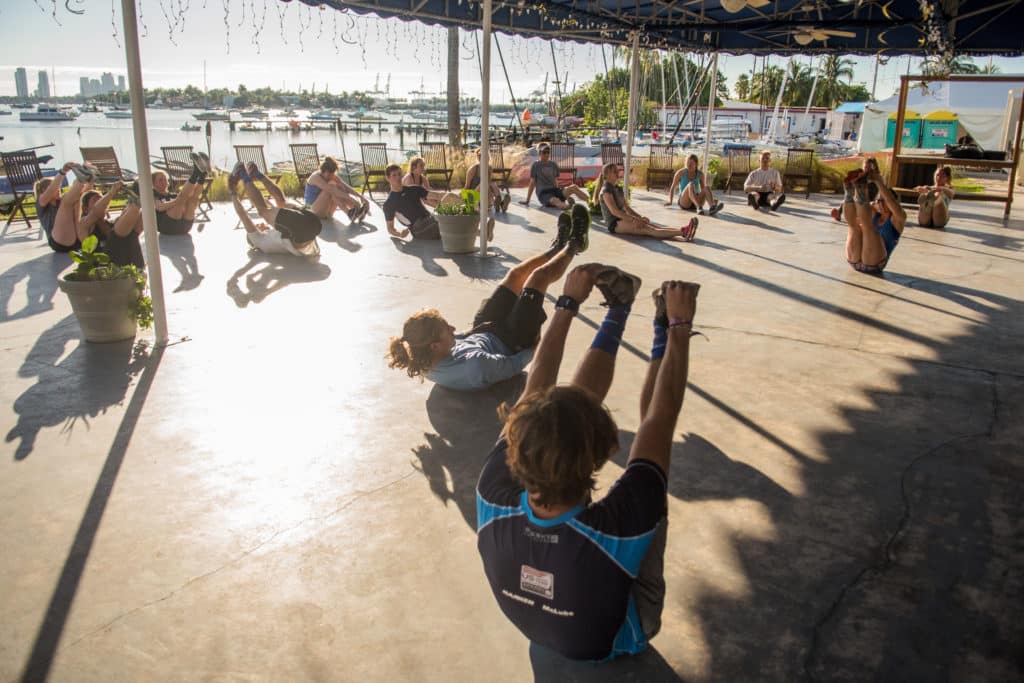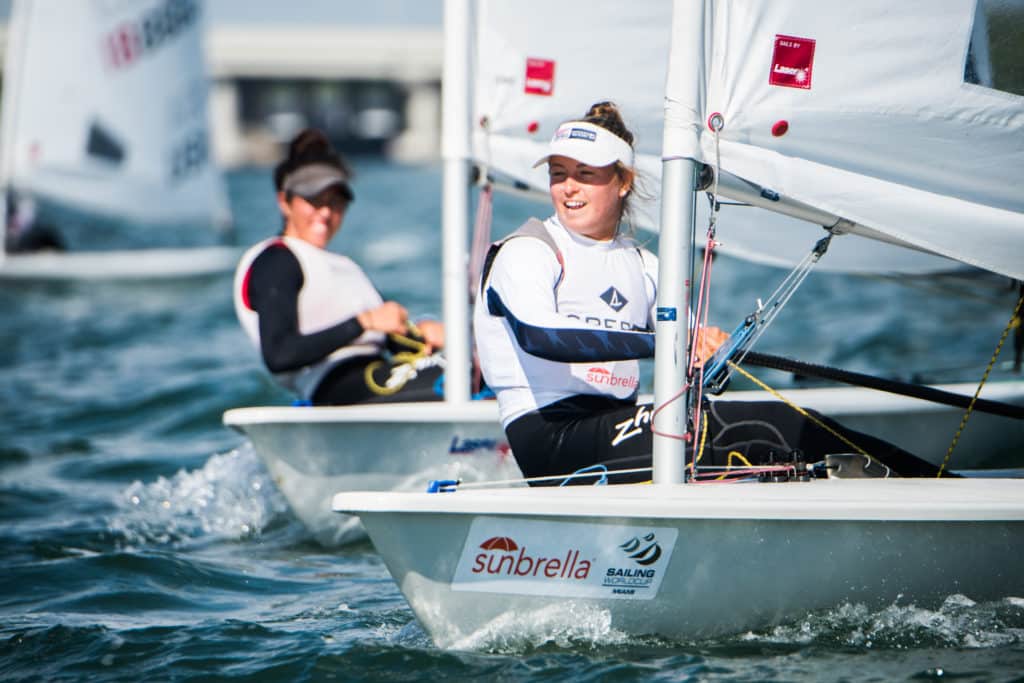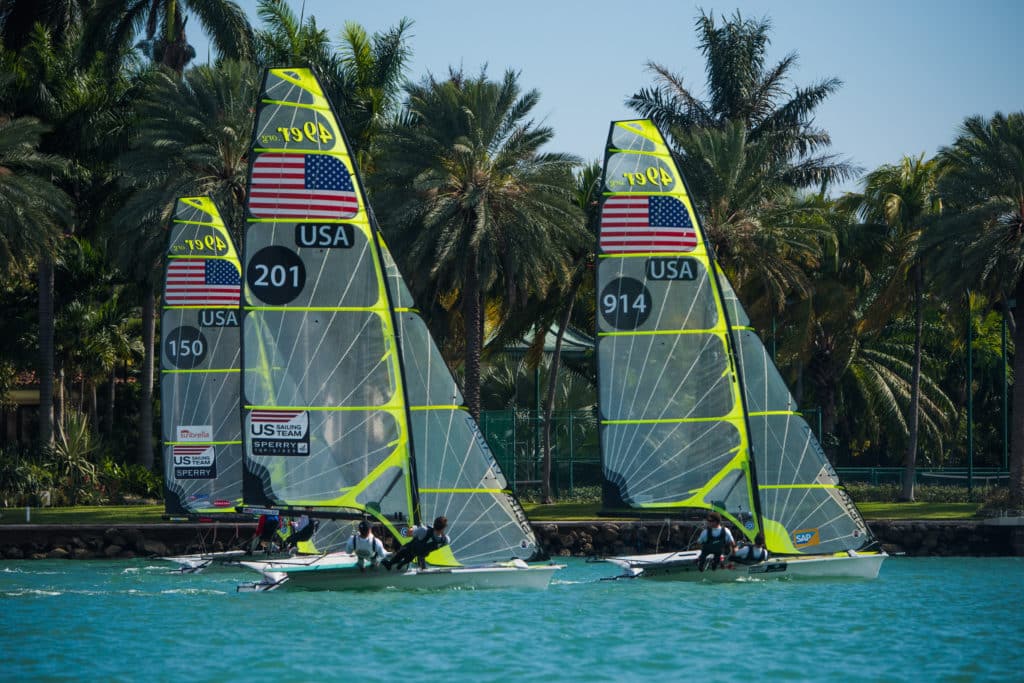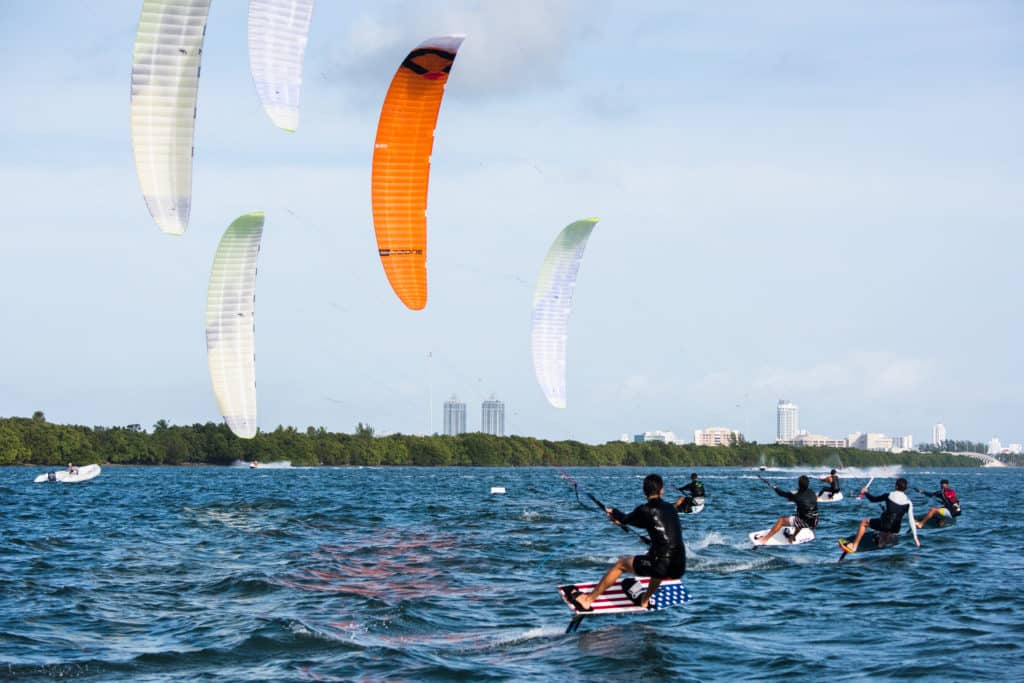
I t’s a sunny, light-breeze afternoon with gentle rolling swells, we’re a few miles off Miami, and Wiley Rogers and crew Jack Parkin, two of the country’s most promising young dinghy sailors, are working with Olympic coach Dave Ullman. They’re fresh off a crushing win in 420s at the Youth World championship and now, at the ripe ages of 17 and 18, respectively, they’re ratcheting up to the next level — a 470 campaign that, with wide-eyed, youthful optimism, might lead to Tokyo in 2020.
The afternoon eventually winds down, and the boys lower their sails in preparation for the tow back to the Miami Yacht Club, host for the first US Sailing Team camp of the new quad. As they’re rolling sails, another 470 materializes out of the haze. It’s Rio Olympians Stu McNay and Dave Hughes, already training for 2020, and they’re flying an Olympic spinnaker emblazoned with a large American flag. Rogers stands in the cockpit, tiller in one hand and, with the other, points to the Olympic spinnaker, now about a quarter-mile away.
“Hey, we need one like that!” he says.
Intentional or not, his words are a stealthy, symbolic shot across the bow of the veteran Olympians. A grin appears from under Ullman’s signature white mustache. “You’ll get yours,” he replies, “someday.”
For 85 sailors at the Miami YC, preparations for “someday” are happening here and now — the first day of the new year, and just in case anyone has forgotten that detail, reminders still swing in the breeze under the patio awning, remnants of the club’s New Year’s Eve party.
There have been team camps in the past, but this one is different — a new era, if you will. It includes all the current Olympic-class boats, plus kiteboards. It embraces Olympic veterans as well as past and present Olympic hopefuls. And it includes a select, invitation-only group of talented youth sailors, including Rogers and Parkin, some of whom are still in high school, who have been invited to play with the big kids, so to speak. They’re members of the U.S. Youth Worlds Team as well as participants in the Olympic Development Program, which began hosting camps in 2015.

“It’s the perfect balance of old guard and new blood,” says Leandro Spina, Development Director of the U.S. team. “This is when our vision comes together. We develop young talent in youth classes, and then we guide them through the first steps into an Olympic class. This is the very first camp, since we’ve had ODP in place, where we close that loop.”
What exactly is ODP? Unlike previous youth programs, there is no roster. In fact, it’s an educational system rather than a team.
“The idea,” says the team’s Olympic communications manager, Will Ricketson, “is to connect top youth sailors with world-class coaching.” And because it’s a system rather than a team, there is “a free flow of kids in and out of ODP, based on how they race at key evaluation events, progress in their knowledge base, and their response to coaching.”
According to Spina, Mac Agnese, age 22, represents ODP bringing in the next generation of sailors. As a youth, Agnese went through now-defunct U18 and Development teams. Then he got involved in ODP.
“This is the biggest concentration of really good, young talent I’ve experienced,” says Agnese, who has won two medals in the ISAF youth worlds in two different classes and has his sights set on the Olympics in the 49er. He’s sold on the program. “All the resources and awesome coaching are provided,” says Agnese. “And you get to sail with a lot of really good sailors from around the country in a lot of different boats.” Agnese was also a college sailor and points out that while college sailing is great, “at the end of the day, you’re sailing FJs and 420s. Now, I’m sailing 49ers and cats.”
There are two other significant pieces to Spina’s loop to be completed. One is location. “From the Miami YC, we have the ocean, we have the bay, and we have what we call the middle racecourse,” says Spina. “On any given day, we can get flat water, chop, swell, shifty winds, steady winds, current and no current. And when you go out into the ocean and go south of the cut, you’ll get a different sea state than if you went north.” In other words, it provides training in virtually every condition an athlete might encounter in any venue around the world. The accommodating Miami YC, which basically turns the keys over to the team for the week, delivers a perfect training incubator.
The other piece is the 20 elite coaches who sign up to work at this camp. US Sailing’s outgoing high-performance director Charlie McKee, himself a two-time Olympic medalist, assembled the group. “We have a bunch of people who believe enough in what we are doing,” says McKee, “that they really want to be involved.”
“The coaches here have seen everything before,” says Radial sailor Christina Sakellaris, a high school senior. “Anything that happens to us on the racecourse, mentally or fitness-wise, they’ve seen it; they know how to fix it.”
She points out that working with a number of coaches is also an advantage. “This was only the second time I met Luther [Carpenter], and the way he was describing the middle zone today in the debrief really clicked for me. I know he coached Anna [Tunnicliffe] at the Olympics, and it’s cool because Anna’s coached me before, so now I know where she got some of the things she taught me.”

How the coaches approach the sailors, especially the younger ones, is what stands out most. Senior Olympic coach Carpenter, who has helped teams win five medals in four different classes, says: “Our approach to coaching these younger, talented kids is that we’re not coaching down to them. We’re coaching at the highest levels and hoping they’re going to be sponges, taking it all in.”
Stick around for the post-race debriefings, and you’ll see Carpenter’s hope materialize. On the Miami YC patio and in adjacent rooms, the sponges soak feverishly. At one table, Rulo Borojovich from Argentina, who coached Anna Tunnicliffe to a gold medal in 2008, is meeting with the Laser Radial sailors. Tunnicliffe, back in the Radial after a seven-year hiatus, is seated next to him. One table over, Ullman, who coached the U.S. women’s 470 team in Rio, huddles with Rogers and Parkin around a computer, looking at sail shapes. Nearby, Italian Peitro Sibello, a two-time Olympian helm in the 49er class, is reviewing 49er material, taking notes for a later meeting. In a room off the patio, Ed Baird, a top pro sailor and the last U.S. competitor to win the Laser Worlds long ago, debriefs the Laser full-rig sailors.
The most intensely focused group is found at the FX team table. Willie McBride, who coached Paris Henken and Helena Scutt, U.S. Olympic representatives in Rio, is working with the eight young women, including Henken and Scutt. They assembled before everyone else, and once other groups have broken up for the day, they’re still at it. Listen in, and you’ll hear McBride eventually wrap up the session — with homework. “I want you to think about and write down everything you think goes into a good tack,” he says. “Weight placement, mechanics, anything else that makes it work.”
The group quickly scribbles down the assignment before finally closing their notebooks.
T here’s also a playfulness that occasionally interrupts the camp’s serious tone. On Wednesday morning, the fleet is launching, and the two women’s 470 teams are already on the water. Rogers and Parkin’s boat is still on the dolly, jib up, as they fuss with final details.
Olympian Annie Haeger, whom Ullman coached in the last quad, shows up to drop off a mainsail for the boys. They were her training partners before the Games. She yells over to them, “Hey, the other boats are already heading out. Why aren’t you out there?”
Parkin responds, “We’re on Ullman time.”
To which Haeger quickly retorts: “Ullman time means on time. Get out there!”
Each day starts with Tunnicliffe leading a CrossFit workout. The first day, they do a half-hour warm-up of sprints and stretches, and then wrap it up with 100 burpees. It’s obvious who participated by the dirt stains on their T-shirts. A couple of the guys stumble back to the yacht club and plunge into the pool. Most everyone drops into a chair somewhere.
The tone is set.

From here, it’s off to a tent erected to one side of the Miami YC building. Inside is a basic classroom configuration — whiteboard and flat-screen TV at one end, American flag hanging in the corner, and a sea of plastic chairs. The tent barely holds the participants, coaches and dozen or so other people involved in the program. After the first day, the tent begins filling well before the start time; it’s clear that being up front — here as well as on the starting line — has its advantages. Carpenter emcees the sessions, which focus on general information valuable to anyone — regardless of which class they sail — as well as touching on some high points from the previous day.
Next, participants meet in their specific classes. I join Ed Baird, Brett Davis and Rulo Borojovich as they meet with the Laser and Laser Radial sailors. The first day begins with introductions, and the game seems to be who can be the most modest about their achievements, perhaps because everyone realizes the caliber of athletes and coaches surrounding them. Even Baird begins by saying that he “did pretty well in the Laser a while back.” When participant Chris Barnard says, “I haven’t been in the boat in a bit…,” Baird finishes his sentence by saying, “…since you won the collegiate singlehanded nationals.”
And it goes on from there. At one point, Baird notices only a few people are taking notes — mostly the Radial girls — and he quickly admonishes the group. “You’ve gotta write this stuff down. You’re not gonna remember it all.”
For younger sailors, having Olympians as role models is a camp highlight. Sakellaris says: “As a youth sailor, I idolized the people I’m now getting to sail against, which is really awesome. But, it also changed my perspective. You can get down about your performance sometimes; then you meet someone who has done the Olympics and didn’t perform well, or someone who almost qualified. You understand that you’re not supposed to succeed every day. It’s supposed to be difficult.”
Afternoons are spent on the water, and there, lessons from the veterans were highly focused. “It’s really cool because if you aren’t sure what to do, just look over, and there’s the Olympic gold medalist [Anna Tunnicliffe], and you can check out what she’s doing,” says Sakellaris. “At one point, I was sailing downwind near her, and she yelled over to me: ‘Hey, don’t do that! Do this instead!’”
According to coach Mike Ingham, the old path for U.S. Olympic sailors was get good, in large part by competing in Europe, and then get funding. “Our new approach is a move away from the heavy emphasis on going to Europe,” he says, “which becomes very expensive.” It’s also clear to Ingham that “this far out, we don’t know who the superstars, the top sailors, are going to be. It’s a more collaborative approach. The seasoned people are here to set the bar.” McKee agrees. “We don’t believe in people just going off and doing their own thing. We believe in teamwork and supporting each other.”
One of the biggest challenges for younger sailors is striking a balance between big-time commitments to sailing and pressures to excel at school and establish careers. Parkin acknowledges there are going to be complications. “I think US Sailing is trying to focus on how to handle the integration of college sailing and Olympic sailing,” he says. “Wiley and I are just going to see how it goes as we go along.” Tokyo — and 2024, wherever it may be — is a long way away, but they’re on the right path.









